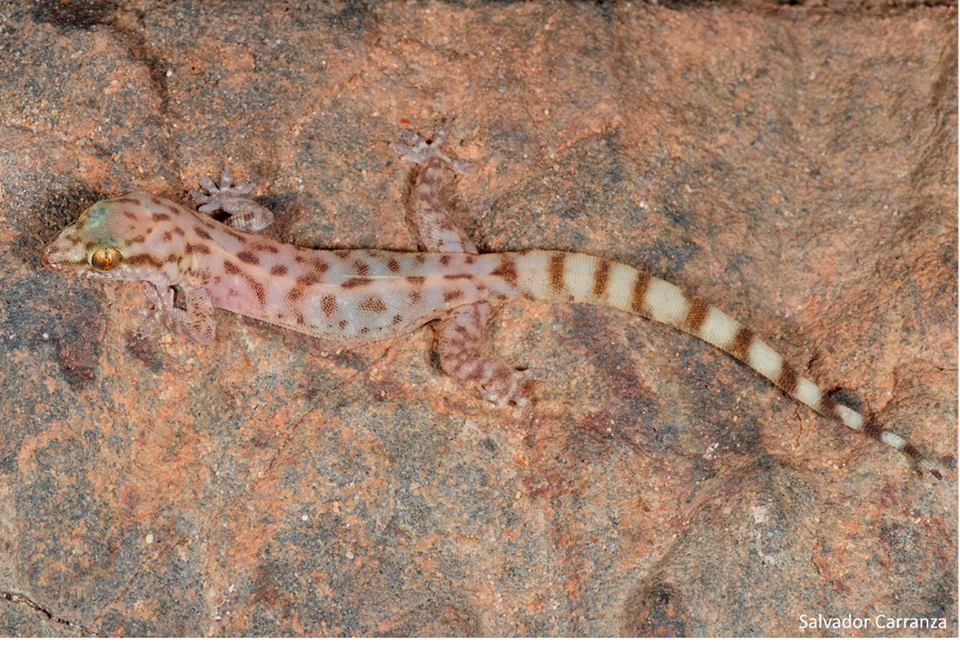Systematics and biogeography of Hemidactylus homoeolepis Blanford, 1881 (Squamata: Gekkonidae), with the description of a new species from Arabia
Raquel Vasconcelos & Salvador Carranza

Abstract
A new species of gecko of the genus Hemidactylus (Squamata: Gekkonidae) is described from Oman and extreme
eastern Yemen. Hemidactylus minutus sp. nov. is characterized morphologically by its very small size, being the smallest Hemidactylus in mainland Arabia, absence of enlarged tubercles anywhere on the body, expanded subcaudal scales beginning some way from tail base, number of preanal pores, number of lamellae under the first and fourth toes, and weakly contrasted black and white banded pattern on the ventral part of tail. It is also genetically distinct from H. homoeolepis to which it has previously been referred, and from all other closely related Hemidactylus from the arid clade in DNA sequence data for mitochondrial (12S, cyt b, ND4) and three nuclear (RAG1, MC1R, c-mos) markers. An adult female from southern Yemen and a badly preserved juvenile from southwestern Saudi Arabia previously assigned to H. homoeolepis are morphologically differentiated from this species and from H. minutus sp. nov. and temporarily referred to as Hemidactylus sp. 12 and Hemidactylus sp. 13, respectively until more specimens are collected and analyzed.
Up to now, H. homoeolepis was the only non-endemic native species of the Socotra Archipelago. With the
description of H. minutus sp. nov., all native reptile species of Socotra are now endemic, such that this archipelago has one with the highest number of endemic reptiles in relation to its small size. In addition, as a result of our taxonomic change, the area of occupancy and extent of occurrence of H. homoeolepis have changed dramatically and thus its conservation status should be updated. Although H. minutus sp. nov. seems widely distributed and relatively abundant, its conservation status should also be re-evaluated.
E’ stata descritta una nuova specie di geco appartenente al genere Hemidactylus (Squamata: Gekkonidae) distribuita in Oman e nell’estremo Yemenn orientale. Hemidactylus minutus sp. nov. è morfologicamente caratterizzato da piccole dimensioni ed è il più piccolo Hemidactylus del contiente arabo, presenta totale assenza dei grossi tubercoli sul corpo con squame subcaudali espanse a partire dalla base della coda, il numero dei pori preanali, il numero di lamelle sotto il primo e quarto dito, debolmente contrastato con un pattern a bande chiare e scure sulla parte anteriore della coda. E’ inoltre geneticamente distinto da H. homoeolepis al quale era precedentemente riferito e da tutti gli altri Hemidactylus strettamente correlati dal clade arido nei dati di sequenza del DNA mitocondiale (per 12S, cyt b, ND4) e tre marcatori nucleari (RAG1, MC1R, c-mos). Una femmina adulta proveniente dal Sud dello Yemen e un giovane mal conservato proveniente da Sud-Ovest dell’Arabia Saudita sono stati assegnati a H. homoeolepis, differenziati morfologicamente da questa specie e da H. minutus sp. nov. e di cui si fa temporaneamente riferimento grazie a più campioni raccolti e analizzati di Hemidactylus sp. 12 e Hemidactylus sp. 13.
Fin ora H. homoeolepis era l’unica specie nativa non endemica dell’arcipelago di Socotra. Con la descrizione di H. minutus sp. nov. tutte le specie di rettili native di Socotra sono ora endemiche, la ricerca ha verificato che questo arcipelago ha il numero più grande di rettili endemici in relazione alle sue piccole dimensioni.
Inoltre, in aggiunta, come risultati della nostra ricerca tassonomica, l'area di occupazion, la presenza e l'estensione della di H. homoeolepis sono cambiate drasticamente portando ad un aggiornamento dell’intero stato di conservazione.
Sebbene H. minutus sp. nov. sembra ampiamente distribuito e relativamente abbondante, il suo stato di conservazione deve essere rivalutato.
